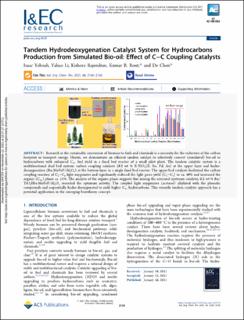| dc.contributor.author | Yeboah, Isaac | |
| dc.contributor.author | Li, Yahao | |
| dc.contributor.author | Rajendran, Kishore | |
| dc.contributor.author | Rout, Kumar Ranjan | |
| dc.contributor.author | Chen, De | |
| dc.date.accessioned | 2022-09-19T07:51:23Z | |
| dc.date.available | 2022-09-19T07:51:23Z | |
| dc.date.created | 2021-05-31T13:01:10Z | |
| dc.date.issued | 2021 | |
| dc.identifier.citation | Industrial & Engineering Chemistry Research. 2021, 60 (5), 2136-2143. | en_US |
| dc.identifier.issn | 0888-5885 | |
| dc.identifier.uri | https://hdl.handle.net/11250/3018710 | |
| dc.description.abstract | Research in the sustainable conversion of biomass to fuels and chemicals is a necessity for the reduction of the carbon footprint in transport energy. Herein, we demonstrate an efficient tandem catalyst to selectively convert (simulated) bio-oil to hydrocarbons with enhanced C4+ fuel yield in a fixed bed reactor of a small pilot plant. The tandem catalytic system is a multifunctional dual bed system; carbon coupling catalysts (0.2 wt % X-TiO2(X: Ru, Pd, Au) at the upper layer and hydro-deoxygenation (Ru-MoFeP/Al2O3) at the bottom layer in a single fixed bed reactor. The upper-bed catalysts facilitated the carbon coupling reaction of C2–C4 light oxygenates and significantly reduced the light gases yield (C1–C5) to ca. 40% and increased the organic (C4+) phase ca. 15%. The analysis of the organic phase suggests that among the screened upstream catalysts, 0.2 wt % Ru/TiO2||Ru-MoFeP/Al2O3 recorded the optimum activity. The coupled light oxygenates (acetone) alkylated with the phenolic compounds and sequentially hydro-deoxygenated to yield higher C4+ hydrocarbons. This versatile tandem catalytic approach has a potential application in the emerging biorefinery concept. | en_US |
| dc.language.iso | eng | en_US |
| dc.publisher | ACS | en_US |
| dc.rights | Navngivelse 4.0 Internasjonal | * |
| dc.rights.uri | http://creativecommons.org/licenses/by/4.0/deed.no | * |
| dc.subject | Redox reactions | en_US |
| dc.subject | Oxides | en_US |
| dc.subject | Catalysts | en_US |
| dc.subject | Biofuels | en_US |
| dc.subject | Aromatic compounds | en_US |
| dc.title | Tandem hydrodeoxygenation catalyst system for hydrocarbons production from simulated bio-oil: Effect of C-C coupling catalysts | en_US |
| dc.type | Peer reviewed | en_US |
| dc.type | Journal article | en_US |
| dc.description.version | publishedVersion | en_US |
| dc.rights.holder | © 2021 The Authors. Published by American Chemical Society | en_US |
| dc.source.pagenumber | 2136-2143 | en_US |
| dc.source.volume | 60 | en_US |
| dc.source.journal | Industrial & Engineering Chemistry Research | en_US |
| dc.source.issue | 5 | en_US |
| dc.identifier.doi | 10.1021/acs.iecr.1c00113 | |
| dc.identifier.cristin | 1912826 | |
| cristin.ispublished | true | |
| cristin.fulltext | original | |
| cristin.qualitycode | 2 | |

